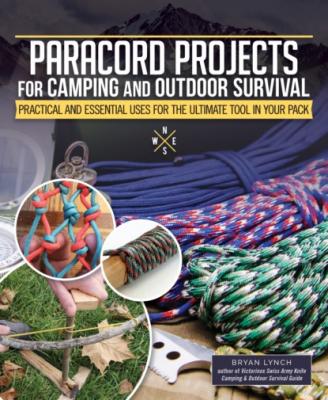ТОП просматриваемых книг сайта:
Understanding Wood Finishing, 3rd Revised Edition. Bryan Lynch
Читать онлайн.Название Understanding Wood Finishing, 3rd Revised Edition
Год выпуска 0
isbn 9781607657347
Автор произведения Bryan Lynch
Жанр Сделай Сам
Издательство Ingram
Honda Knot
While you may not be familiar with how to make the Honda knot, I can almost guarantee you have seen it in action. This is the knot that is used to create an adjustable loop, like that used for a lasso.
1. Make an overhand knot toward the end of the paracord.
2. Make a small loop by passing the end of the paracord back over the main cord.
3. Push the cut end of the paracord through the backside of the loop.
4. Hold onto the loop you just pushed through with one hand, and in the other hand, hold onto the overhand knot end of the paracord. Pull the loop all of the way through to tighten the paracord onto itself.
5. The final step is very similar to the final step in the Running Bowline (here). Pass the longer end of the paracord through the loop, and you will now have an adjustable loop.
6. In step 5, the loop that is shown around the main body of the paracord is quite large. I did that for demonstration purposes. Generally, however, I make that loop much smaller. The above picture is more accurate.
Reef Knot
The reef knot, or the square knot, is used when you want to join two pieces of cordage of the same diameter. Other than the overhand knot, this is probably one of the most well-known knots. I use this knot often, and I think everyone should know it, as it is very simple to make.
1. The first step is to take the ends of two pieces of paracord and lay them over one another so that they form an X. Next take one of the working ends and go over and under the opposite cord so that it looks like the picture above.
2. Repeat the previous two steps with the working ends so that the same pattern is made above the first one. I used two different colors to help illustrate that the same-color working ends are pointed in the direction of the same-color standing ends.
3. Pull the working and standing ends of the same color to tighten the knot.
Hitches
Hitches are used to attach rope to a pole or post. While there are a variety of uses for hitches, I tend to use them as way of holding the paracord at the beginning or end of a lashing.
Half Hitch
The half hitch by itself is not all that useful, but variations of it are often used with other hitches or knots.
1. To form the half hitch, wrap the working end of the paracord around a piece of wood. Then take the working end under and over the standing end, threading the working end through the loop. From here, simply pull the working end and the standing end in opposite directions to tighten the hitch.
Clove Hitch
The clove hitch is effective when the load pulling against it is only doing so perpendicular to the hitch. Movements in any other direction tend to loosen the clove hitch. I usually use this as a temporary means of attaching cordage to another object.
1. Make one full turn around the piece of wood with the paracord so that the working end overlaps the standing end.
2. Make one more turn around the piece of wood with the working end and pull the end of the cord underneath the top piece.
3. Slide the two loops together and pull the working end and the standing end in opposite directions to tighten the hitch.
Trucker’s Hitch
I have also heard this hitch referred to as the canoemen’s hitch. It is a useful hitch to know when securing a load or a ridgeline for a shelter.
1. First create a loop with the working end passing over the standing end to the left.
2. Next bring the working end under the standing end and through the loop in order to make a second loop. Then pass the working end up through the first loop as shown.
3. Pull the working end and the standing end to tighten the loop.
4. Wrap the working end around the anchor point, such as a tree. Next, thread the working end through the loop and pull on it as hard as you need to in order to take up the slack in the standing end.
5. To finish the trucker’s hitch, wrap the working end into two half hitches.
Timber Hitch
The timber hitch is a quick way of attaching cordage to an object so that the object can be pulled or moved. It can also be used as the beginning of certain lashings, which is what I mainly use it for.
1. With the working end of the paracord, make one turn around the object it is being tied to. Then make one turn around the standing end so that it forms a smaller loop.
2. Twist the working end of the paracord several times around itself as shown above.
3. Finally, pull the working end and the standing end in opposite directions

